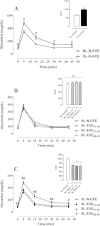Low-intensity and moderate exercise training improves autonomic nervous system activity imbalanced by postnatal early overfeeding in rats
- PMID: 24914402
- PMCID: PMC4049453
- DOI: 10.1186/1550-2783-11-25
Low-intensity and moderate exercise training improves autonomic nervous system activity imbalanced by postnatal early overfeeding in rats
Abstract
Background: Postnatal early overfeeding and physical inactivity are serious risk factors for obesity. Physical activity enhances energy expenditure and consumes fat stocks, thereby decreasing body weight (bw). This study aimed to examine whether low-intensity and moderate exercise training in different post-weaning stages of life is capable of modulating the autonomic nervous system (ANS) activity and inhibiting perinatal overfeeding-induced obesity in rats.
Methods: The obesity-promoting regimen was begun two days after birth when the litter size was adjusted to 3 pups (small litter, SL) or to 9 pups (normal litter, NL). The rats were organized into exercised groups as follows: from weaning until 90-day-old, from weaning until 50-day-old, or from 60- until 90-days-old. All experimental procedures were performed just one day after the exercise training protocol.
Results: The SL-no-exercised (SL-N-EXE) group exhibited excess weight and increased fat accumulation. We also observed fasting hyperglycemia and glucose intolerance in these rats. In addition, the SL-N-EXE group exhibited an increase in the vagus nerve firing rate, whereas the firing of the greater splanchnic nerve was not altered. Independent of the timing of exercise and the age of the rats, exercise training was able to significantly blocks obesity onset in the SL rats; even SL animals whose exercise training was stopped at the end of puberty, exhibited resistance to obesity progression. Fasting glycemia was maintained normal in all SL rats that underwent the exercise training, independent of the period. These results demonstrate that moderate exercise, regardless of the time of onset, is capable on improve the vagus nerves imbalanced tonus and blocks the onset of early overfeeding-induced obesity.
Conclusions: Low-intensity and moderate exercise training can promote the maintenance of glucose homeostasis, reduces the large fat pad stores associated to improvement of the ANS activity in adult rats that were obesity-programmed by early overfeeding.
Keywords: Autonomic nervous system; Glucose homeostasis; Moderate exercise training; Overfeeding-induced obesity; Parasympathetic nervous system.
Figures



References
-
- Armitage JA, Poston L, Taylor PD. Developmental origins of obesity and the metabolic syndrome: the role of maternal obesity. Front Horm Res. 2008;36:73–84. - PubMed
LinkOut - more resources
Full Text Sources
Other Literature Sources
